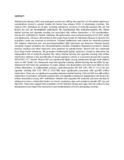| dc.contributor.author | Maleche-Obimbo, Elizabeth | |
| dc.contributor.author | Yatich, Nelly | |
| dc.contributor.author | Ndukwe, Lillian | |
| dc.contributor.author | Njoroge, Julia | |
| dc.contributor.author | Sakr, Sameh | |
| dc.contributor.author | Antouny, Neveen El | |
| dc.contributor.author | Attwa, Fr. Mena | |
| dc.contributor.author | Crothers, Kristina | |
| dc.contributor.author | Chung, Michael | |
| dc.date.accessioned | 2015-06-16T15:17:21Z | |
| dc.date.available | 2015-06-16T15:17:21Z | |
| dc.date.issued | 2015-02-26 | |
| dc.identifier.citation | Maleche-Obimbo, Elizabeth., Yatich, Nelly., Ndukwe, Lillian., Njoroge, Julia., Sakr, Sameh., Antouny, Neveen El., Attwa, Fr. Mena., Crothers, Kristina ., Chung, Michael(2015). Risk factors for airflow obstruction among HIV individuals in Nairobi, Kenya. Conference on Retroviruses and Opportunistic Infections. (Poster abstract 800).February 23-26, 2015 Seattle, Washington 2015 | en_US |
| dc.identifier.uri | http://www.croiconference.org/sites/default/files/uploads/croi2015-program-abstracts.pdf | |
| dc.identifier.uri | http://hdl.handle.net/11295/84945 | |
| dc.description.abstract | Antiretroviral therapy (ART) and prolonged survival are shifting the spectrum of HIV-related pulmonary complications toward a greater burden of chronic lung
disease (CLD). In developing countries, this impacts HIV+ individuals at all ages, including adolescent survivors of vertically-acquired HIV, yet risk factors for CLD are incompletely
understood. We hypothesized that vertically-acquired HIV, indoor biofuel burning and cigarette smoking are associated with airflow obstruction, a CLD manifestation, among
HIV+ individuals in Nairobi.
Methods: We performed a cross-sectional analysis of 451 HIV+ adults and adolescents ≥10 years old enrolled in the Coptic Hope Center for Infectious Diseases in Nairobi; HIV
acquisition route was assessed at enrolment. Included adolescents met criteria for vertically-acquired HIV. Subjects underwent pre- and post-bronchodilator (BD) spirometry per
American Thoracic Society standards. Oxygen saturation was measured before and after ambulation. Respiratory symptoms, biofuel burning, smoking and other exposures were
gathered via questionnaires. Recent CD4 was abstracted from Hope Center databases. We generated multivariable logistic regression models to determine the independent risk of
vertically-acquired HIV, indoor biofuel burning and cigarette smoking with airflow obstruction, defined as the post-BD ratio of forced expiratory volume in 1 second to forced vital
capacity (FEV1/FVC) <0.7.
Results: Recent CD4 was significantly higher among adolescents though most subjects were on ART (Table). No adolescents reported cigarette smoking. Biofuel burning did not
differ by age. Adolescents had twice the prevalence of cough, phlegm and desaturation and were more likely to have airflow obstruction. In multivariable analyses, verticallyacquired
HIV (OR 2.84, 95% CI 1.12-7.20) and cigarette smoking (OR 3.11, 95% CI 1.23-7.86) were significantly associated with post-BD airflow obstruction. There was no significant
association between biofuel burning, CD4 and ART use with airflow obstruction.
Conclusions: Vertically-acquired HIV and cigarette smoking are independent risk factors for airflow obstruction among HIV+ individuals. Children who acquired HIV vertically
and have survived to adolescence have a substantial burden of chronic respiratory signs and symptoms despite ART use and high CD4. These data suggest that acquisition of HIV
infection during early ages that are critical in lung development may impact the mechanisms and manifestations of CLD in developing countries. | en_US |
| dc.language.iso | en | en_US |
| dc.publisher | University of Nairobi | en_US |
| dc.title | Risk factors for airflow obstruction among HIV individuals in Nairobi, Kenya | en_US |
| dc.type | Presentation | en_US |
| dc.type.material | en | en_US |

